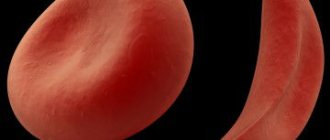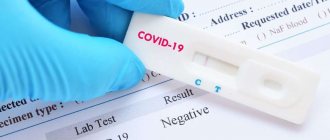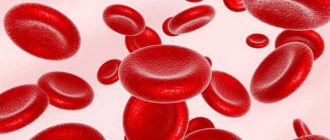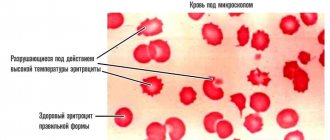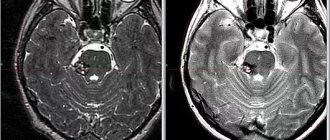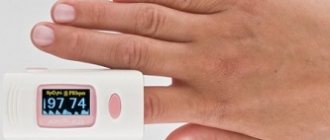Published: 03/30/2021 17:00:00 Updated: 03/30/2021
Erythrocytes are red blood cells, the most numerous blood cells. Formally, they are not cells, since during the process of maturation they lose many of the structures necessary for cells. For example, they lack nuclei and do not synthesize any protein molecules, unlike other cells in the body. So the name “cell” in this case is used for convenience. Red blood cells are formed in the bone marrow and constantly circulate in the body, performing the most important function of maintaining life - they carry oxygen from the lungs to tissues and organs and remove carbon dioxide.
In addition to red blood cells, blood contains plasma, platelets, and leukocytes. However, the number of red blood cells is so large that just a couple of drops of blood contains about one billion of these cells. They make up about 40% of the total blood volume. Actually, it is red blood cells that give our blood its characteristic red color due to its hemoglobin content.
Red blood cells do not last forever, they wear out over time and eventually die. The average life cycle of a red blood cell is approximately 120 days—a total of four months. However, do not worry, the bone marrow is constantly producing new cells and maintaining the required level of red blood cells. Various unfavorable circumstances can reduce or, conversely, increase their reproduction rate and affect their life expectancy - thus, the balance of blood composition is disrupted. An increase or decrease in red blood cells is associated with various pathological conditions. Let's consider this issue in more detail.
What are red blood cells?
Even those who are far from medicine sometimes ask questions: what are red blood cells in the blood? What are they needed for? Along with platelets and leukocytes, these blood cells are formed in the red bone marrow of vertebrates, including humans. They are the most numerous and participate in the life of all systems, facilitating the movement of oxygen through tissues and organs. Because of their shape and unique plasticity, red blood cells can easily move through capillaries, facilitating gas exchange.
The structure of red blood cells
The structure and functions of red blood cells make them plastic and easily deformable. The liquid contents of cells - the cytoplasm - is rich in hemoglobin, which contains a divalent iron atom that binds oxygen. The same pigment gives the bodies their red color. Red blood cells are disc-shaped and do not have a nucleus, which is lost during maturation. The composition of red cells is as follows:
- reticular stroma;
- hemoglobin-filled cell;
- dense shell.
The structure of human red blood cells is simplified: inside there is a membrane resembling a mesh, while the plasma membranes of leukocytes and platelets are more complex. The membrane of red cells is special - it is impermeable to cations (with the exception of potassium), but it allows chlorine anions, oxygen molecules and carbon dioxide to pass through well.
How are red blood cells formed in the blood?
How are red blood cells formed? Tissue growth occurs through the multiplication of one cell, called proliferation. After this, the stem cells, as the ancestors of hematopoiesis, form a large body with a nucleus, which is lost as the red blood cell grows. Once in the bloodstream, the body is transformed into a ready-made red blood cell. The process takes up to 3 hours, and red cells are formed in the body without interruption.
Every second, more than 2 million red blood cells are formed in the bone marrow of the spine, skull and ribs, in addition - in the endings of the arms and legs (in children). Circulating in the blood for 3-4 months (about 110 days), red blood cells are absorbed by macrophages and destroyed in the spleen and liver. A small part of them undergoes phagocytosis - capture by solid particles of cells - in the vascular bed. The transfer of oxygen throughout the body and participation in the transfer of carbon dioxide are the central functions of red blood cells. Cell production begins in the fifth month of fetal development.
Composition of blood, blood cells. Red blood cells
The internal environment of the body (IBE) consists of blood, lymph and tissue fluid.
Blood is a type of connective tissue consisting of a liquid intercellular substance of complex composition - plasma - and cells suspended in it - blood cells: erythrocytes (red blood cells), leukocytes (white blood cells) and platelets (blood platelets).
Tissue fluid is part of the plasma that has come out of the blood capillaries. Tissue fluid is in direct contact with the cells of the body and exchanges substances with them. To return this fluid back into the blood, there is a lymphatic system.
Lymph is a component of the internal environment of the human body, a type of connective tissue, which is a transparent liquid.
Lymph flows through the lymphatic vessels, is cleared in the lymph nodes and returns to the veins of the systemic circulation.
The internal environment of the body is characterized by homeostasis , i.e. relative constancy of composition and other parameters. This ensures the existence of body cells in constant conditions, independent of the environment. The maintenance of homeostasis is controlled by the hypothalamus (part of the hypothalamic-pituitary system).
Blood
In the human body, the amount of blood is on average 4.5–5 liters.
Blood plasma by volume is 55–60%, and formed elements – 40–45%.
1 mm3 of blood contains 4.5–5 million erythrocytes, 5–8 thousand leukocytes, 200–400 thousand platelets.
Blood plasma is a yellowish translucent liquid. It consists of water (90–92%), minerals and organic substances (8–10%), 7% proteins, 0.7% fats, 0.1% glucose, the rest of the dense plasma residue is hormones, vitamins, amino acids, metabolic products.
Formed elements of blood
Erythrocytes are anucleate red blood cells that have the shape of biconcave discs. This shape increases the cell surface by 1.5 times. Red blood cells make up almost half of the blood volume, which explains its very high ability to bind oxygen; the oxygen capacity of the blood is 20%. 1 mm3 of blood contains from 4 to 5 million red blood cells.
The cytoplasm of erythrocytes contains the protein hemoglobin - a complex organic compound consisting of the protein “globin” and the blood pigment “heme”, which contains iron in the form of Fe3+ ions.
The cells of mature red blood cells lack a nucleus, i.e. red blood cells are nuclear-free cells. Red blood cells also do not have mitochondria. This not only frees up extra space for hemoglobin, but also forces them to respire anaerobically, meaning without consuming the oxygen they carry.
Hemoglobin reversibly binds oxygen (converting into oxyhemoglobin) in places with high concentrations and releases it in places with low concentrations. Red blood cells also contain the enzyme carbonic anhydrase, which is involved in the transport of carbon dioxide CO2.
The main function of red blood cells is to transport oxygen and carbon dioxide.
Life cycle of red blood cells
The lifespan of red blood cells is 120–130 days.
Red blood cells develop from nucleated cells in the red bone marrow of cancellous bone. During the process of maturation, they lose their nucleus and enter the blood. They are destroyed in the liver and spleen. Bile pigment is formed from hemoglobin. The protein part of the erythrocyte is broken down into amino acids, and iron is released from the non-protein (pigment) part of hemoglobin, called heme, and is stored in the liver as part of the iron-containing protein ferritin. Iron can then be reused in the formation of new red blood cells or for the synthesis of cytochromes.
The rest of the heme molecule is broken down to form two bile pigments, red bilirubin and green biliverdin. They are excreted into the intestines as part of bile.
What function do red blood cells perform?
Blood cells play an important role in the human body.
In addition to carrying oxygen to tissues from the lungs, the functions of red blood cells in the blood include:
- Reverse transport of carbon dioxide to the lungs from tissues.
- Transfer of useful amino acids on its surface.
- Delivery of water from tissues to the lungs. It is released in the form of steam.
- Isolation of erythrocyte coagulation factors.
- Regulation of blood viscosity, which, due to the participation of red cells, is smaller in small vessels compared to large ones.
- Blood test after chemotherapy: normal, interpretation, general blood test
Respiratory function of red blood cells
The acid-base state, that is, the ratio of hydroxyl and hydrogen ions in the biological environment, is regulated by red blood cells. They transport O2 and CO2 from tissues to the lungs. Gas exchange is the main function of red blood cells.
How it works:
- Inhaled oxygen enters the lungs. Blood cells squeeze through narrow vessels and tiny capillaries there.
- The iron in hemoglobin captures oxygen, causing the pigment to change color from blue to red. And red blood cells carry the collected oxygen throughout the body.
- Hydrogen is oxidized by body cells, and at the same time carbon dioxide is formed. Most of it returns through the lungs, but some molecules remain on the red blood cells.
Nutritional function of red blood cells
When answering the question what function red blood cells perform, they mention transport. But they “transport” not only oxygen and carbon dioxide, but also useful substances. Essential amino acids and lipids are concentrated on the surface of red cells, getting there from the plasma, and are transported to tissue cells. This is the nutritional function of red blood cells.
Protective function of red blood cells
An important function of red blood cells is to protect the body from harmful substances. On the surface of red blood cells there are proteins of a protein nature. Thanks to them, red blood cells are able to bind some toxins and neutralize them, acting as a protector against poisons. In addition, red cells take part in blood coagulation, hemostasis (vascular-platelet) and fibrinolysis - the process of dissolving blood clots.
Enzymatic function of red blood cells
Red blood cells are carriers of various enzymes. This is another transport function of red blood cells in human blood. All enzymes in blood cells can be divided into three types:
- Red blood cells in the blood: functions, normal content and reasons for deviation from reference values
- regulating oxygenation and dioxygenation;
- facilitating the performance of transport functions;
- providing biological processes with energy.
The norm of red blood cells in the blood (x 1012 in 1 l.)
To determine the level of lymphocytes, capillary or venous blood is collected. Standards:
- For a woman: from 3.7 - 4.7
- For a pregnant woman: 3–3.5.
- For men: 4 - 5.1.
If your blood test shows elevated red blood cells (erythrocytosis), this indicates a disorder that can pose a serious health hazard.
There are two types of erythrocytosis: primary - it is rare and is a hereditary disease; secondary - is a consequence of acquired diseases.
Diseases that provoke a pathological increase in the level of red blood cells in the blood:
- Vaquez disease
- heart defects
- lung diseases
- malignant tumors
- Aerz's disease
- Pickwick's syndrome
Other causes of increased red blood cells not related to disease:
- insufficient amount of enzymes necessary for digestion
- dehydration
- drinking low-quality water (for example, chlorinated or too carbonated)
- lack of vitamins
- smoking
Due to the oversaturation of red blood cells, the blood acquires a thicker consistency, which leads to a deterioration in the processes of respiration and the supply of blood to cells.
Failures in blood supply lead to disruptions in the functioning of the cerebral cortex. The patient also shows an increase in the volume of the liver, spleen and kidneys. All complications arising from erythrocytosis can ultimately lead to death.
What do red blood cells look like?
The structure of red blood cells is related to the function they perform, and in appearance they differ from other blood cells circulating in the body. They have a different – special – shape and size. By nature, blood cells are endowed with peculiar features - tiny size, flattened disk shape, absence of a nucleus. This is necessary in order to quickly cope with the transport of gas in the blood.
Shape of red blood cells
Red blood cells are a flattened, biconvex disc (discocyte). The intracellular space is increased due to the lack of membrane partitions and a nucleus, which mature erythrocytes of all mammals lack. The shape of human red blood cells also increases their total surface area. Inside the bodies there is an increased volume of the protein pigment hemoglobin, which binds oxygen and carbon dioxide molecules.
The specific form increases the efficiency of the basic function of all red blood cells. However, the entire mass of blood cells is heterogeneous. Along with the cells of the regular shape of the biconvex disc, there are others, their percentage of the total number is small (less than 10%). This:
- flat-surfaced squamous cells;
- aging types of these cells - echinocytes;
- spherical spherocytes;
- dome-shaped stomatocytes.
Red blood cells - sizes
The diameter of blood cells varies from 6 to 8.2 micrometers (µm). The maximum thickness is only 2 microns. The tiny size makes it easy to move through microscopic capillary vessels. Modern medicine calls the phenomenon when the normal size of red blood cells increases in one direction or another: macrocytosis and microcytosis. The diameter of healthy cells is 7-9 microns, they are called normocytes. Everything below is microcytes, and everything above is macrocytes.
Decreased red blood cells
The main symptoms of low red blood cell count are:
- Weakness or fatigue.
- Lack of energy.
- Paleness of the skin.
Reduced red blood cells are a relatively common pathology.
A low number of red blood cells and/or hemoglobin is called anemia. If there are few red blood cells, there is correspondingly less hemoglobin in the bloodstream, which carries oxygen. Thus, the body experiences oxygen starvation, and we feel weakness, drowsiness, loss of vitality, and dizziness. Due to anemia, hair falls out, the skin becomes pale and dry. There are many forms of anemia, each with its own cause. Anemia can be temporary or acquired; depending on severity - from mild to severe. According to a 2015 publication in The Lancet, about one-third of the world's population is anemic.
The most common causes of low red blood cells are:
- Unbalanced diet with deficiency of iron, vitamin B12 or folic acid.
- Damage to the bone marrow (toxins, radiation or chemotherapy, infection, certain medications).
- Any bone marrow disease.
- Chronic inflammatory processes.
- Bleeding in the digestive tract (for example, from ulcers, polyps, colon cancer).
- Heavy menstrual bleeding.
- Trauma with massive blood loss.
- Conditions that cause the destruction of red blood cells (for example, hemolytic anemia caused by autoimmune processes or defects in the red blood cells themselves).
- Kidney failure – serious kidney pathologies lead to a decrease in erythropoietin (or hematopoietin), a kidney hormone that promotes the production of red blood cells.
The risk of anemia is higher in the following groups:
- children aged from 6 months to 2 years;
- pregnant or recently given birth women;
- following a diet low in vitamins, minerals and iron, red meat;
- patients who regularly take medications that cause inflammation of the gastric mucosa (for example, ibuprofen);
- having a family history of hereditary anemia such as sickle cell anemia or thalassemia;
- patients with an intestinal disorder that affects the absorption of nutrients (eg, Crohn's disease);
- have recently experienced major blood loss due to surgery or injury;
- people with chronic diseases (HIV, diabetes, kidney disease, cancer, rheumatoid arthritis, heart failure, liver disease).
The structure of frog red blood cells
Scientists have long established that human red blood cells have structural features that ensure the most efficient gas exchange. This applies to form, quantity, and internal content. This is especially obvious when the structure of human and frog red blood cells is compared. In the latter, red blood cells are oval in shape and contain a nucleus. This significantly reduces the content of respiratory pigments. Frog red blood cells are much larger than human ones, and therefore their concentration is not so high. For comparison: if a person has more than 5 million of them per cubic mm, then in amphibians this figure reaches 0.38.
White blood cells - leukocytes
Leukocytes perform protective functions; as soon as an infection enters the body, white blood cells - leukocytes - come into play. Leukocytes are constantly on guard. Some white blood cells (lymphocytes) produce protective antibodies - proteins that neutralize or destroy viruses and pathogenic bacteria.
The life cycle of leukocytes is relatively short - from several days to several weeks. One cube of blood from a healthy person contains from 4 to 8 thousand leukocytes. If the body is fighting an infection, this number may increase. A persistently too high or too low number of white blood cells in the blood may indicate the presence of serious illnesses.
General principles of the existence of red blood cells
An erythrocyte is a cell derived from the red germ of hematopoiesis. About 2.4 million of these cells are produced per day, they enter the bloodstream and begin to perform their functions. During the experiments, it was determined that in an adult, red blood cells, the structure of which is significantly simplified compared to other cells of the body, live 100-120 days.
In all vertebrates (with rare exceptions), oxygen is transferred from the respiratory organs to the tissues through hemoglobin in erythrocytes. There are exceptions: all representatives of the family of “white-blooded” fish exist without hemoglobin, although they can synthesize it. Since at the temperature of their habitat, oxygen dissolves well in water and blood plasma, these fish do not require more massive oxygen carriers, which are erythrocytes.
- Red blood cells - what are they? Why is red blood cell count important?
